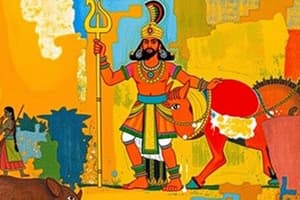Podcast
Questions and Answers
How did the Mauryan administrative structure ensure efficient governance across its vast territories?
How did the Mauryan administrative structure ensure efficient governance across its vast territories?
- Through a highly centralized system with provinces managed by royal representatives and regular inspections by royal officials. (correct)
- By granting autonomous powers to all provincial governors, reducing central oversight.
- Through strict adherence to a single legal code, uniformly applied across the empire without considering local customs.
- By eliminating the Mantriparishad, thus preventing delays.
What role did the Arthashastra play in shaping the administrative and economic policies of the Mauryan Empire?
What role did the Arthashastra play in shaping the administrative and economic policies of the Mauryan Empire?
- It provided detailed guidelines on the duties of kings, ministers, and officials, and emphasized a strong economy for state stability. (correct)
- It acted as a comprehensive military manual, detailing strategies for conquest and defense but omitting governance.
- It was a compilation of folk tales and legends used to educate citizens about their cultural heritage, having no impact on policy.
- It served primarily as a religious text that indirectly influenced moral governance and trade ethics.
How did the Mauryan economic policies contribute to the empire's stability and prosperity?
How did the Mauryan economic policies contribute to the empire's stability and prosperity?
- By depending entirely on tribute from conquered regions, avoiding internal taxation and economic development.
- By isolating the empire from external trade to preserve resources, focusing solely on agrarian self-sufficiency.
- By regulating economic activities, investing in infrastructure, promoting trade through standardized measures, and maintaining monopolies in key industries. (correct)
- By implementing a laissez-faire system with minimal state intervention, allowing private entities to control most economic activities.
Which of the following best exemplifies the Mauryan's contribution to art and architecture, reflecting their cultural achievements?
Which of the following best exemplifies the Mauryan's contribution to art and architecture, reflecting their cultural achievements?
What was the significance of the Brahmi script developed during the Mauryan period?
What was the significance of the Brahmi script developed during the Mauryan period?
How did Ashoka's conversion to Buddhism influence the Mauryan Empire's policies and its impact on society?
How did Ashoka's conversion to Buddhism influence the Mauryan Empire's policies and its impact on society?
What strategies did Ashoka employ to spread Buddhism beyond the Mauryan Empire?
What strategies did Ashoka employ to spread Buddhism beyond the Mauryan Empire?
What role did war elephants play in the Mauryan army, and how did this reflect their military innovations?
What role did war elephants play in the Mauryan army, and how did this reflect their military innovations?
How did the Mauryan Empire's approach to military strategy evolve under Ashoka, and what impact did this have on the empire?
How did the Mauryan Empire's approach to military strategy evolve under Ashoka, and what impact did this have on the empire?
Which combination of factors contributed to the Mauryan Empire's success in expanding and maintaining its vast territories?
Which combination of factors contributed to the Mauryan Empire's success in expanding and maintaining its vast territories?
Flashcards
Mauryan King (Rajan)
Mauryan King (Rajan)
Head of the Mauryan state with supreme power.
Samaharta
Samaharta
Chief Collector of Revenue in the Mauryan administration.
Sannidhata
Sannidhata
Chief Treasury Officer in the Mauryan administration.
Senapati
Senapati
Signup and view all the flashcards
Mantriparishad
Mantriparishad
Signup and view all the flashcards
Arthashastra
Arthashastra
Signup and view all the flashcards
Ashoka's Dhamma
Ashoka's Dhamma
Signup and view all the flashcards
Ashoka's Pillars
Ashoka's Pillars
Signup and view all the flashcards
Mauryan Stupas
Mauryan Stupas
Signup and view all the flashcards
Mauryan Intelligence
Mauryan Intelligence
Signup and view all the flashcards
Study Notes
- The Mauryan Empire (c. 322 - 185 BCE) was a geographically extensive Iron Age historical power in ancient India, founded by Chandragupta Maurya.
- It was the first major empire in the Indian subcontinent.
Administrative Structure
- The Mauryan Empire had a highly centralized administrative system.
- The King (Rajan) was the head of the state, possessing supreme power.
- He was the source of all authority.
- The empire was divided into provinces for administrative convenience.
- Provinces were governed by princes or royal representatives.
- Key officials in the central administration included:
- The Samaharta (Chief Collector of Revenue).
- The Sannidhata (Chief Treasury Officer).
- The Senapati (Commander-in-chief of the army).
- A council of ministers (Mantriparishad) advised the King.
- The Arthashastra, attributed to Chanakya (also known as Kautilya), provides detailed information about the Mauryan administration.
- It outlines the duties of kings, ministers, and other officials.
- The empire maintained a large and efficient bureaucracy to manage its vast territories.
- Local administration was decentralized, with village heads and other local officials responsible for maintaining order and collecting taxes.
- Regular inspections by royal officials ensured the smooth functioning of the administration.
- The Mauryan administration was known for its emphasis on justice and fairness.
- Ashoka's edicts promoted ethical governance and social welfare.
Economic Policies
- The Mauryan economy was primarily agrarian, with agriculture as the main occupation of the people.
- The state played a significant role in regulating economic activities.
- It controlled irrigation, mining, and trade.
- Land revenue was a major source of income for the state.
- Taxes were levied on land, trade, and various professions.
- The state invested in infrastructure development, including roads, irrigation systems, and waterways.
- Trade flourished both internally and externally.
- Major trade routes connected the Mauryan Empire with other parts of the world.
- Standardized weights and measures facilitated trade and commerce.
- The Mauryans introduced a well-organized currency system, with silver and copper coins used for transactions.
- Guilds (shrenis) played an important role in promoting trade and industry.
- The state maintained a monopoly over certain industries, such as mining and salt production.
- Economic policies aimed at promoting prosperity and stability throughout the empire.
- The Arthashastra provides valuable insights into the economic policies of the Mauryan period.
- It emphasizes the importance of a strong economy for the stability of the state.
Cultural Achievements
- The Mauryan period witnessed significant advancements in art, architecture, and literature.
- Ashoka's pillars are iconic examples of Mauryan art and architecture.
- These pillars are characterized by their polished surfaces and elaborate carvings.
- The Sarnath Lion Capital is a particularly famous example.
- Stupas, such as the Great Stupa at Sanchi, were built during this period.
- They served as important religious monuments.
- Rock-cut caves, such as the Barabar Caves, were also constructed.
- They provided shelter for monks and ascetics.
- The Mauryan period saw the development of the Brahmi script.
- It became the foundation for many other Indian scripts.
- Literature flourished under the patronage of the Mauryan rulers.
- Megasthenes, a Greek ambassador to the Mauryan court, wrote the "Indika," providing valuable information about Mauryan society and culture.
- The Mauryan Empire promoted religious tolerance, with Buddhism, Jainism, and other faiths coexisting peacefully.
- The Mauryan court was a center of learning and intellectual activity.
- The Mauryan period laid the foundation for many of the cultural traditions that would characterize later Indian history.
Buddhism And Its Spread
- Buddhism gained prominence during the Mauryan period, particularly under the reign of Emperor Ashoka.
- Ashoka converted to Buddhism after witnessing the carnage of the Kalinga War.
- He embraced Buddhist principles of non-violence, compassion, and tolerance.
- Ashoka played a key role in spreading Buddhism both within and outside the Mauryan Empire.
- He sent missionaries to various parts of India and other countries, including Sri Lanka, Southeast Asia, and Central Asia.
- Ashoka's edicts, inscribed on pillars and rocks throughout the empire, promoted Buddhist teachings and ethical conduct.
- He built numerous stupas, viharas, and other religious monuments.
- This helped to popularize Buddhism.
- The Third Buddhist Council was held during Ashoka's reign at Pataliputra.
- It helped to standardize Buddhist doctrines and practices.
- The spread of Buddhism had a profound impact on the culture and society of the Mauryan Empire.
- Buddhism promoted social equality and challenged the rigid caste system.
- It also encouraged vegetarianism and the protection of animals.
- The Mauryan period is considered a golden age for Buddhism in India.
- The spread of Buddhism during this period had a lasting impact on the religious landscape of Asia.
Military Innovations
- The Mauryan Empire maintained a large and well-organized army.
- The army consisted of infantry, cavalry, elephants, and chariots.
- The Mauryans were pioneers in the use of war elephants.
- They played a crucial role in their military campaigns.
- The Arthashastra provides detailed information about the organization and training of the Mauryan army.
- The Mauryans developed advanced siege warfare techniques.
- They used various types of siege engines and fortifications.
- They also made use of spies and intelligence networks to gather information about their enemies.
- The Mauryan army was known for its discipline and its ability to operate in diverse terrains.
- Chandragupta Maurya's military conquests established the Mauryan Empire as a major power in the Indian subcontinent.
- Ashoka's policy of Dhamma Vijaya (conquest through righteousness) emphasized non-violence and diplomacy over military force.
- However, the Mauryan army remained a powerful force throughout his reign.
- The military innovations of the Mauryan period contributed to the empire's success in expanding and maintaining its vast territories.
Studying That Suits You
Use AI to generate personalized quizzes and flashcards to suit your learning preferences.




